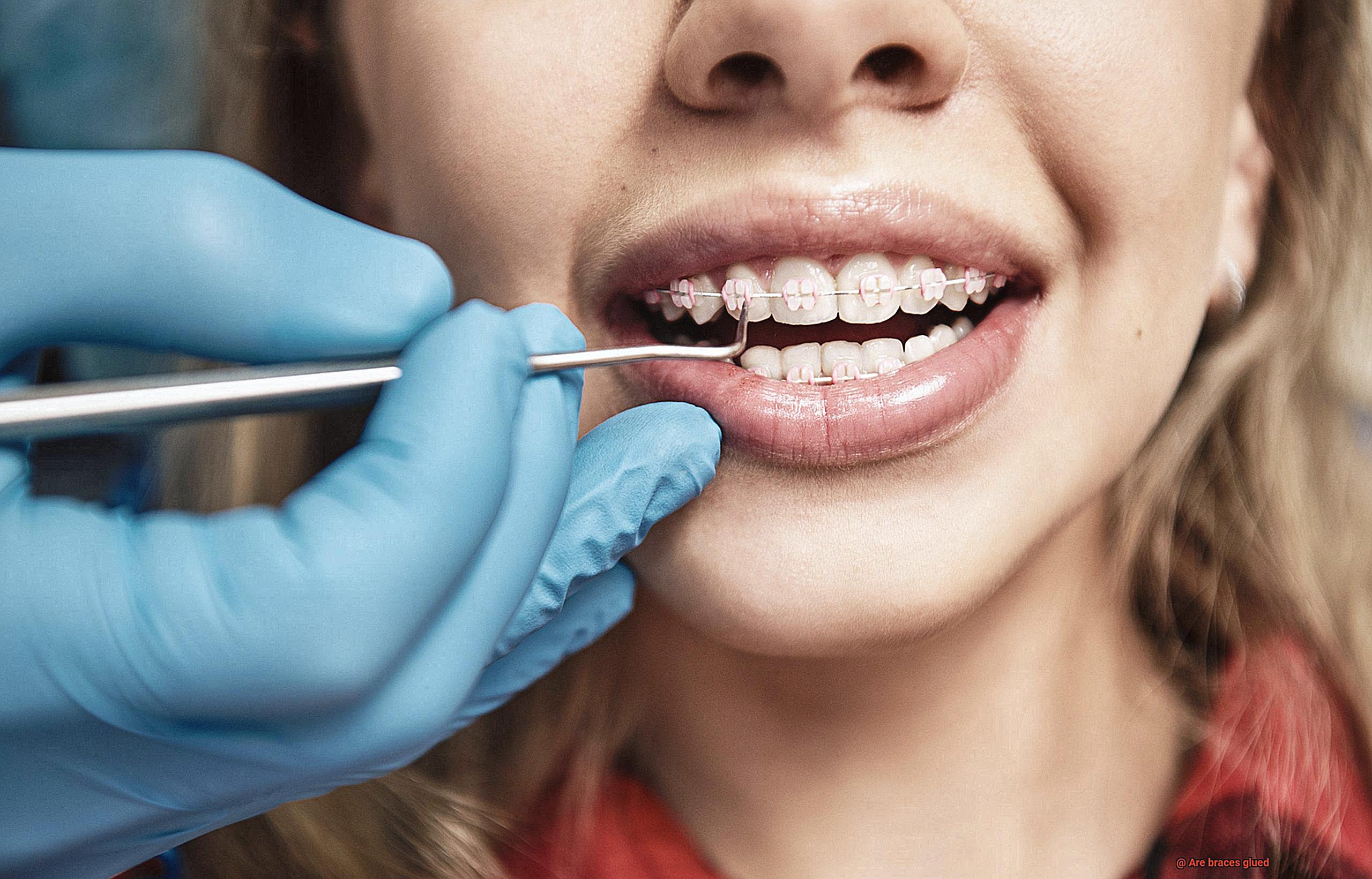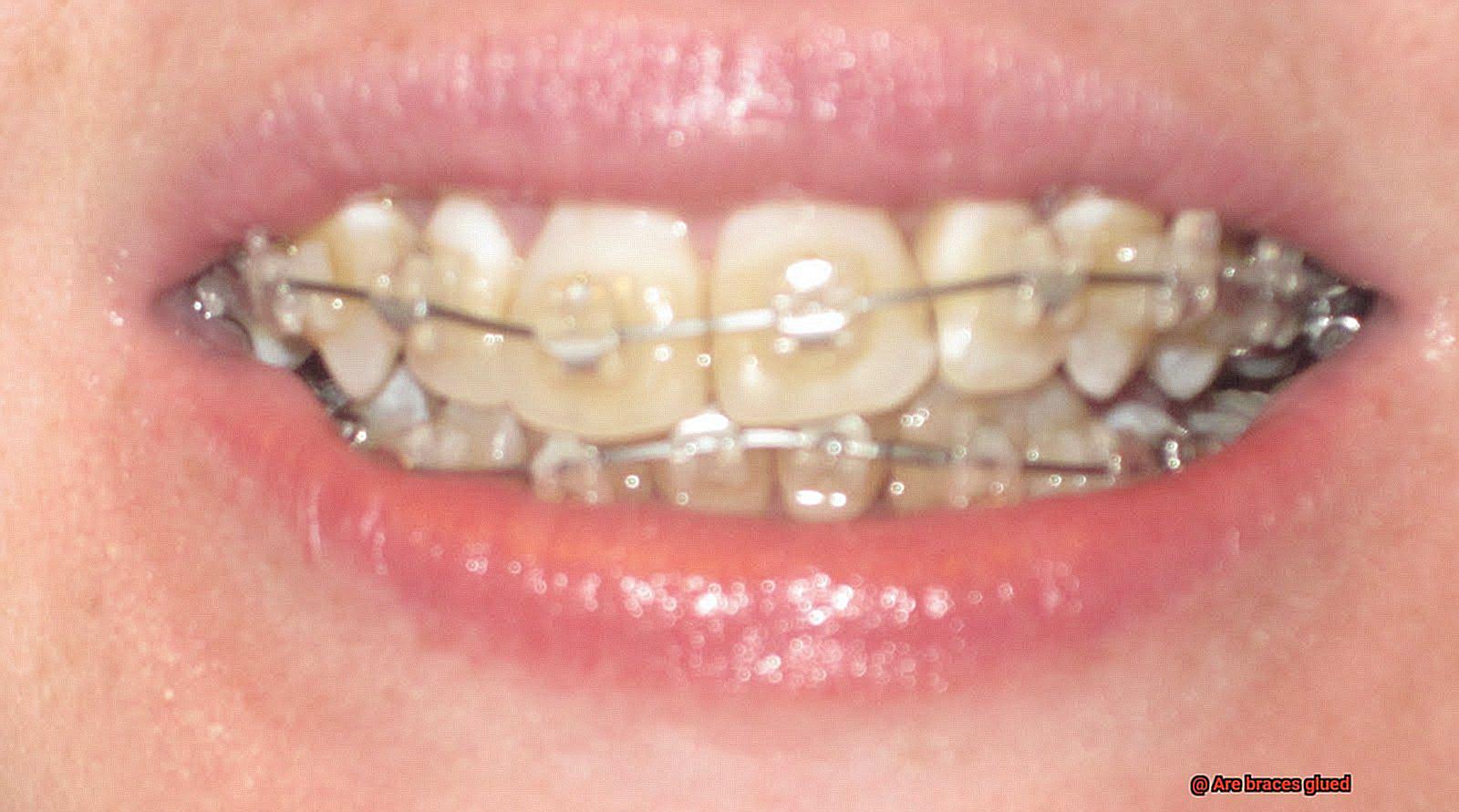Ready to learn all about the fascinating world of braces? Well, buckle up because we’re about to dive into the nitty-gritty details of how those bad boys get stuck onto your teeth.
And no, they’re not just casually placed on there like a sticker – it’s a precise and careful process involving some dental adhesive magic. So, if you’ve ever wondered how braces stay put throughout your treatment, stick around (pun intended) as we break it down step by step.
Get ready to uncover the secrets behind that straight and dazzling smile of yours.
What is the Bonding Process for Braces?
Contents
- 1 What is the Bonding Process for Braces?
- 2 What Type of Adhesive is Used for Braces?
- 3 How Long Does it Take to Securely Bond Braces?
- 4 Is the Bonding Process Painless?
- 5 Can the Adhesive be Removed Easily if Needed?
- 6 How Can I Ensure My Braces Remain Securely Bonded?
- 7 Tips for Maintaining Good Oral Hygiene with Braces
- 8 Conclusion
In this article, we will take a closer look at the bonding process for braces, debunking the myth of “gluing” and shedding light on the use of dental adhesives. Understanding this process will not only ease any concerns but also ensure a successful orthodontic treatment.
Step 1: Preparing the Teeth
Before the bonding process begins, your orthodontist takes meticulous care to clean and dry your teeth. This step is crucial as it allows for optimal adhesion. By removing any plaque or debris using polishing paste and air drying the teeth, the orthodontist ensures a clean surface for better contact between the adhesive and tooth enamel.
Step 2: Applying the Bonding Agent
Once your teeth are prepped, a special bonding agent is applied to their surface. This remarkable adhesive acts like glue, creating a strong bond between the tooth enamel and the brackets. Composite resin, known for its safety and excellent adhesive properties, is commonly used as a bonding agent.
Step 3: Placing the Brackets
With the bonding agent in place, your orthodontist carefully positions each bracket onto the tooth’s surface. It’s essential to achieve proper alignment because it determines how your teeth will move during treatment. The orthodontist’s expertise comes into play here, ensuring that each bracket is placed precisely.
Step 4: Curing the Adhesive

To secure the brackets in place, a special light or curing device is used to activate the bonding agent. This process causes the adhesive to harden rapidly, creating a robust connection between the bracket and tooth. With its quick curing time, this step typically takes only a few seconds per tooth.
Step 5: Attaching Archwires (optional)
Once all the brackets are securely bonded, your orthodontist may attach archwires to guide your teeth into their desired positions. These archwires provide gentle pressure for gradual and controlled movement, ultimately leading to that perfectly aligned smile.
What Type of Adhesive is Used for Braces?

When it comes to braces, you may have heard people talk about “gluing” the brackets to your teeth. But let’s clear up one thing – there’s no actual glue involved. Instead, orthodontists use a special adhesive called orthodontic adhesive or dental cement. This magical substance is specifically designed for use in the mouth and is what keeps those braces securely in place.
So, what exactly is this orthodontic adhesive made of? It consists of two main components – a resin component and a filler component. The resin component provides the adhesive properties, allowing the brackets to stick to the teeth, while the filler component adds strength and stability to the adhesive.
But how does this adhesive work its magic? Well, it’s all about the light. The adhesive used for braces is light-cured, meaning it hardens when exposed to a special light source. This process activates a chemical reaction within the adhesive, ensuring that it sets quickly and securely.
Now, you might be wondering about the different consistencies of the adhesive. Orthodontic adhesives come in various viscosities, allowing orthodontists to choose the right consistency for their needs. Some adhesives are more flowable, making them easier to apply, while others are more viscous, providing better control during placement.
Before applying the adhesive, orthodontists may also use a separate etchant or primer on the tooth surface. This helps improve the bond strength between the tooth and the bracket, ensuring a strong and durable bond throughout your treatment.
But what about saliva and other oral fluids? Don’t worry – this adhesive is specially designed to be resistant to them. Even though your mouth is a wet environment, the adhesive will stay strong and keep your braces securely in place.
When it’s time to say goodbye to your braces, removing the adhesive is a breeze. The orthodontist can easily remove it without causing any damage to your teeth.
It’s important to note that orthodontic adhesives undergo rigorous testing and meet specific standards set by regulatory bodies to ensure their safety and effectiveness. So you can trust that the adhesive used for your braces is top-notch.
How Long Does it Take to Securely Bond Braces?
Embarking on an orthodontic journey with braces is an exciting step towards achieving a beautiful smile. However, you may be curious about how long it takes for those tiny brackets to securely bond to your teeth.
Here, we will delve into the process of bonding braces, exploring the materials used and the time required for this crucial step. Let’s dive in and discover all the details.
The Process:

Preparing the Teeth:
Before bonding the braces, your orthodontist ensures that your teeth are clean and dry. This allows for optimal adhesion of the dental glue.
Applying the Dental Glue:
Now comes the thrilling part – applying the dental glue. Your orthodontist uses a special adhesive called composite resin. This safe and effective material is designed to create a strong bond between the braces and your teeth.

Positioning the Brackets:
With the dental glue applied, your orthodontist meticulously positions each bracket on your teeth. This step demands precision and expertise to ensure proper alignment.
Curing with a Light:
To activate and harden the dental glue, a curing light is used. This light triggers a chemical reaction in the adhesive, securely bonding the braces to your teeth.
Timeframe:
The duration of the bonding process can vary depending on factors like the type of adhesive used and your orthodontist’s technique.
On average, it typically takes between 10 minutes to an hour for the dental glue to fully cure and create a secure bond with your teeth. During this period, it’s important to keep your mouth open and minimize movement or talking to avoid disrupting the bonding process.
Maintenance is Key:
While having securely bonded braces is undoubtedly exciting, it’s crucial to remember that maintaining this bond throughout your orthodontic treatment requires proper oral hygiene practices and regular check-ups with your orthodontist. By diligently following their instructions and taking good care of your teeth, you can ensure a stable foundation for your braces.
Is the Bonding Process Painless?
Embarking on an orthodontic journey with braces is like setting sail towards a beautiful smile. But before you can set sail, you need to secure your braces in place through a process called bonding. Now, I know what you’re thinking, “Is the bonding process painful?” Well, let me put your mind at ease. The bonding process for braces is generally considered to be a painless procedure.
So how does it all work? Let’s break it down:
- Clean and Dry: Before the bonding process begins, your orthodontist will ensure that your teeth are thoroughly cleaned and dried. This step ensures optimal adhesion of the brackets.
- Adhesive Application: Next, a small amount of dental adhesive, usually a composite resin material, is applied to the back of each bracket. This adhesive is specially designed for bonding orthodontic brackets and is safe for oral use.
- Bracket Placement: With the adhesive in place, your orthodontist carefully positions each bracket on your teeth. It’s like playing a game of dental Tetris.
- Light Cure: Once all the brackets are in place, a specialized light is used to cure the adhesive. This light activates the adhesive, creating a secure bond between the brackets and your teeth.
Now, you might be wondering if you’ll experience any discomfort during this process. The good news is that most patients find the bonding process to be relatively painless. In fact, many only report feeling slight pressure or discomfort that quickly subsides.
However, everyone’s pain tolerance is different. In rare cases, patients with particularly sensitive teeth may experience some temporary sensitivity during or after the bonding process. But fear not. Over-the-counter pain relievers can help manage any discomfort if necessary.
So there you have it. The bonding process for braces is generally painless and well-tolerated by patients. Now, you can set sail on your orthodontic journey with confidence, knowing that the process of securing your braces will be smooth sailing. Bon voyage to a beautiful smile.
Can the Adhesive be Removed Easily if Needed?
Braces have long been a go-to orthodontic treatment for correcting dental misalignments and creating beautiful smiles. However, there may come a time when braces need to be removed temporarily or permanently. In these cases, it is crucial to ensure that the adhesive used to attach the braces can be easily removed without causing any harm or damage to the teeth. This article will delve into the question of whether the adhesive can be removed easily if needed.
Orthodontic Adhesives and Their Properties:
Thanks to advancements in dental technology, orthodontic adhesives have been developed specifically for easy removal. These adhesives are formulated using materials such as resin or glass ionomer cement, which offer excellent adhesive properties and biocompatibility. They provide strong bonding between the brackets and teeth during treatment but allow for safe and gentle removal when necessary.
The Removal Process:
Removing braces requires the expertise of a trained professional, such as a dentist or orthodontist. They employ special instruments to meticulously break the bond between the adhesive and the tooth enamel. The removal process involves applying mild force either manually or with specialized orthodontic pliers. This ensures that the adhesive is safely debonded without causing any harm to the teeth.
Professional Assistance is Key:
It cannot be emphasized enough that removing braces should only be done by a trained professional. Attempting to remove braces at home or by an unqualified individual can lead to serious complications such as enamel damage, tooth fractures, or gum injuries. Seeking professional assistance guarantees that the removal process is carried out safely and efficiently.
Addressing Residual Adhesive:
After the braces have been removed, there may be residual adhesive left on the tooth surface. Dentists have various techniques at their disposal to gently polish off this residue using dental instruments or a high-speed handpiece. They may also utilize mild adhesive removers or polishing pastes to ensure the complete removal of any remaining adhesive.
How Can I Ensure My Braces Remain Securely Bonded?
Braces are the unsung superheroes of orthodontic treatment, working tirelessly to align your teeth and grant you a dazzling smile. But like any superhero, they need to remain securely bonded to your teeth to accomplish their mission effectively. How can you ensure that your braces stay firmly in place? Let’s unravel the secrets and equip you with the knowledge you need to keep those braces securely bonded.
Regular dental visits are your first line of defense. During these appointments, your orthodontist will examine your braces and make necessary adjustments to ensure proper alignment and bonding. Don’t underestimate the power of these check-ups – schedule them diligently and never skip an appointment.
Maintaining excellent oral hygiene is another crucial factor in the longevity of your braces’ bond. Brushing and flossing regularly will prevent plaque buildup, which weakens the adhesive and jeopardizes the stability of your braces. Remember, gentle but thorough cleaning with a soft-bristled toothbrush is key to maintaining the superpowers of your braces.
Speaking of adhesive, it’s vital to note that braces are affixed to your teeth using specialized dental glue. Though remarkably strong, this adhesive isn’t indestructible. Avoid habits that exert excessive pressure on your braces, such as biting hard objects or chewing ice – these heroic accessories deserve tender love and care.
If you notice any issues with your braces, like a loose bracket or wire, don’t hesitate to contact your orthodontist immediately. They possess the superpowers needed to rectify any problems and ensure that your braces remain securely bonded. Whatever you do, avoid attempting DIY fixes – that could lead to even greater trouble.
Lastly, keep in mind that the duration of your treatment with braces may vary depending on individual circumstances. As time progresses, it becomes increasingly important to maintain the secure bond of your braces. So follow your orthodontist’s instructions diligently, care for your oral hygiene meticulously, and keep those regular check-ups marked on your calendar.
Tips for Maintaining Good Oral Hygiene with Braces
I have an arsenal of tips and tricks to help you keep your pearly whites shining throughout your orthodontic adventure. Let’s dive in and discover the secrets to maintaining good oral hygiene with braces.
Brushing and Flossing: Your Teeth’s Dynamic Duo
Brushing your teeth at least twice a day with a soft-bristle toothbrush and fluoride toothpaste is the cornerstone of maintaining good oral hygiene with braces. Pay extra attention to those brackets and wires, as they can harbor food particles and plaque. Remember, flossing is just as crucial. Use floss threaders or orthodontic floss to reach under the wires and banish any sneaky food remnants.
Interdental Brushes: The Braces’ Cleaning Heroes
Enter the tiny superheroes known as interdental brushes – they can navigate between your brackets and wires, reaching those elusive spots that regular brushing might miss. These miniature bristle wonders are perfect for eliminating food particles and plaque from those hard-to-reach nooks and crannies.
Mouthwash: The Breath Freshener Extraordinaire
Introduce an antimicrobial mouthwash into your oral hygiene routine to save the day. It swoops in, slaying bacteria and reducing the risk of gum disease and bad breath. Opt for an alcohol-free mouthwash to prevent dryness and keep your mouth feeling fresh.
Water Pik: Blasting Away Plaque
Unleash the power of a water pik or oral irrigator – your secret weapon for cleaning around braces. With its pulsating stream of water, it heroically eradicates food debris and plaque from between your teeth and around the brackets. Bid farewell to those stubborn bits of food hiding in your braces.
Regular Dental Check-ups: The Orthodontic Watchdogs
Don’t underestimate the importance of regular dental check-ups during your orthodontic journey. Your dentist will vigilantly monitor your oral health, catching any potential issues early on. They’ll also provide professional cleaning to remove tenacious plaque and tartar, ensuring your smile remains impeccable.
Conclusion
In conclusion, braces are not mere stickers that are casually glued onto your teeth. The process of bonding braces involves a meticulous and delicate procedure using dental adhesives. Before the bonding begins, your orthodontist will thoroughly clean and dry your teeth to ensure the best possible adhesion. Then comes the moment when a special bonding agent, typically composite resin, is carefully applied to the surface of each tooth. This adhesive acts as the “glue” that forms a robust bond between the bracket and tooth enamel.
Once the adhesive is in place, your orthodontist will proceed with utmost precision to position each bracket onto the tooth’s surface. Proper alignment is crucial for effective treatment. To secure these brackets firmly, a curing light or device is utilized to activate and rapidly harden the bonding agent.
The adhesive specifically used for braces is specially formulated for oral use and possesses resistance against saliva and other oral fluids. It undergoes rigorous testing to meet stringent safety and effectiveness standards.
When it comes time to remove your braces, fear not. Trained professionals can perform this task without causing any harm to your precious teeth. Special instruments are employed to break the bond between the adhesive and tooth enamel, while any remaining residue can be effortlessly polished away.
To ensure that your braces remain securely bonded throughout your treatment journey, it is vital to maintain excellent oral hygiene practices, attend regular check-ups with your orthodontist, refrain from habits that exert excessive pressure on your braces, and promptly seek professional assistance if you detect any issues with them.






